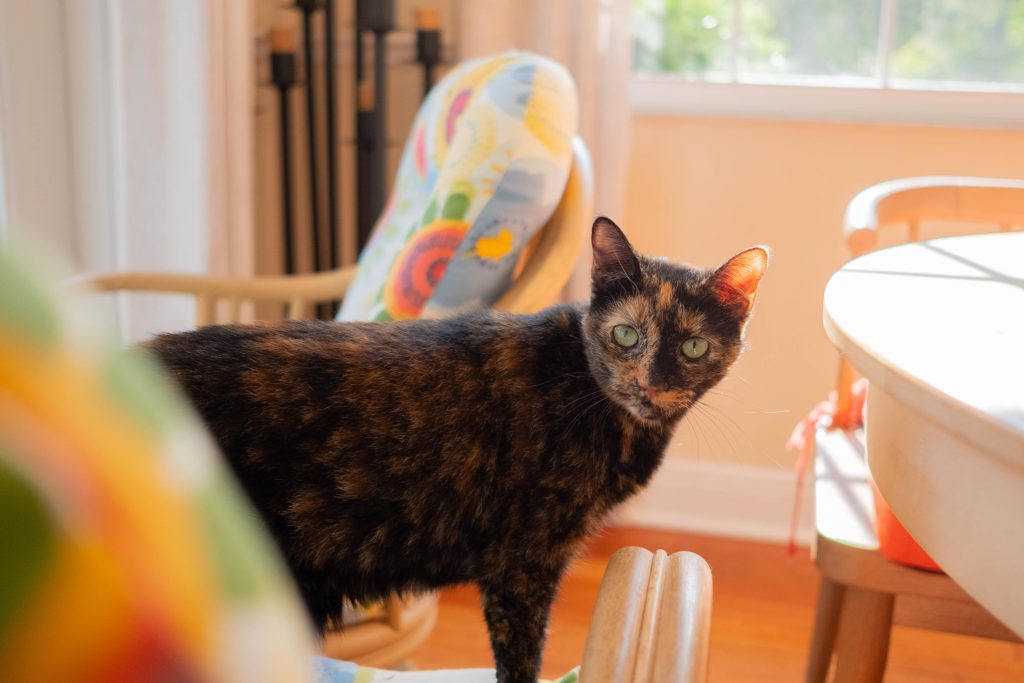If you’re reading this post, your kitty has likely been diagnosed with hyperthyroidism. Congratulations! She has a treatable disease! As a feline-only veterinarian, this is one of the most common conditions that I diagnose and treat. I am (usually) pretty excited at the diagnosis because we have so many treatment options nowadays. You may be wondering, “My cat is hyperthyroid – what does that mean and what should I do? What if I don’t treat it?” Ok, let’s discuss…
My cat is hyperthyroid! What does that mean?
Hyperthyroidism is one of the more common diseases in the senior cat. It is caused by a tumor (that is initially non-cancerous 98% of the time- yay!) of the thyroid gland. The enlarged thyroid gland secretes excessive amounts of thyroid hormone. The thyroid hormone regulates your cat’s metabolism, so the elevated levels speed everything up in her body!

Clinical signs – ants in their pants!
The most common clinical sign of hyperthyroidism is weight loss despite an increased appetite. If your cat is eating a lot but losing weight, it could be hyperthyroidism! There are other diseases that cause these same signs, so a thorough exam and blood work are a must. Other signs include increased drinking and urinating, vomiting, diarrhea and hyperactivity. I can often predict a cat has hyperthyroidism in the exam room because they act like they have ants in their pants! A kitty may be wiggly and not want to sit still, even with a slow, gentle exam. During the physical exam we can often also feel the abnormal thyroid glands on one or both sides of the neck (normally we should not be able to feel these glands).
Hyperthyroidism can also lead to heart disease – yikes! Affected cats may have a heart murmur, cardiac arrhythmias (abnormal heart rhythm), rapid heartbeat or trouble breathing.
A cat left untreated will only have their signs get worse. Plain and simple.
I was told my cat is hyperthyroid…are we sure?
The diagnosis us usually pretty straightforward, unless it’s not. Hyperthyroidism is diagnosed by a blood test called “T4,” which is measuring the level of a thyroid hormone called thyroxine. Cats with hyperthyroidism have elevated T4s. Sometimes the T4 is in a weird “gray zone” range and we have to perform other thyroid testing such as a “fT4” which stands for “free T4” (nope, it’s not free of charge unfortunately) and/or a TSH level (another hormone). Sometimes we even perform really advanced testing called nuclear scintigraphy, but it rarely comes to that.
It is also essential to perform a full blood panel including a complete blood cell count, chemistry panel and urinalysis to evaluate the health of other major organs. Oh, and don’t forget about a blood pressure! Kidney disease in particular may complicate hyperthyroid treatment, but doesn’t make it impossible. Other tests that may be performed are chest x-rays and other heart tests if concurrent heart disease is suspected.
What if your kitty isn’t showing any of these signs (yes, that happens sometimes)? It depends on how confident your veterinarian is of the diagnosis as to what next step they will take. Sometimes if we’re not sure we will just recheck the T4 value (and the cat) in a few months. Cats are famous for “not reading the book” i.e. not following the rules that we humans set for them. The same goes for their medical issues!
My cat is hyperthyroid! What do we do about it?
There are four ways we treat hyperthyroidism.
- Diet: y/d diet made by Science Diet/Hill’s – NO MORE SNACKS ALLOWED!
A therapeutic food has been developed that is low in iodine and has been shown to normalize thyroid levels in hyperthyroid cats. Available in both dry and canned versions, your cat must eat this food 100% of the time to control hyperthyroidism. That’s right. No snacks allowed. If you have non-hyperthyroid cats they can also eat y/d, but they have to have a little bit of “regular” food every day to keep their iodine levels up.
Studies have shown that about 75% of cats’ thyroid levels will “improve” in 28 days but may take much longer to be normal. In some cats, the diet doesn’t work. We still have to perform recheck blood work after starting the diet, just like we would with medication. If your cat has been taking thyroid medication, then she can be started on y/d and weaned off of her medication.
In my experience, the diet either works really well or it’s just not a good fit for that cat.
- Anti-thyroid medication: methimazole
Medication can come in many forms! Everything from oral pills (brand name Felimazole or generic methimazole), compounded liquids, compounded treats and even compounded transdermal medication (a cream rubbed on the inside of the ear).
These medicines work by decreasing the amount of thyroid hormone produced. The hormone levels normalize and your cat will gain her weight back and the other clinical signs will improve or disappear. The medicines are usually given twice daily and must be given for the rest of your cat’s life since they do not cure the disease, but just keep it under control.
Possible side effects of methimazole are vomiting, poor appetite and lethargy. These usually resolve in 1-2 weeks. Other, more severe side effects can be intense itching, liver issues or bleeding problems, but these are rare. This is one of the reasons why we recheck blood work! We don’t only recheck the T4, but liver and kidney tests as well. When we treat the thyroid we also often see kidney disease “unmasked,” which means it was there all along but was hiding behind the hyperthyroidism. Only when we get the thyroid regulated do we know a kitty’s true level of kidney disease.
- Surgical removal – Thyroidectomy
Surgical removal of the enlarged thyroid gland(s) will cure hyperthyroidism. Cats with concurrent kidney disease may not be candidates for this surgery. There are also risks associated with surgery, such as increased anesthesia risk in likely elderly cats, low calcium levels and regrowth of the glands.
- Radiation Therapy – the “Gold Standard” baby!
Radiation treatment also (usually) cures hyperthyroidism. It is the “Gold Standard” for treatment. The real name is “radioactive iodine” or “I-131.” It involves a single injection administered under the skin (similar to how a vaccine is given). Again, cats with advanced stages of kidney disease are not ideal candidates for this treatment. Radiation therapy is done at a referral center where your cat will stay for about 4-5 days while their radiation levels decrease. There are special precautions that have to occur when they come home, like limiting close contact for a short period of time. Recheck blood work is performed as needed. There is also a risk of the injection working too well and causing hypothyroidism (a low T4). All of the potential pros and cons would be discussed prior to choosing I-131 as a treatment.
Curative treatments such as I-131 should be seriously considered in otherwise healthy cats with hyperthyroidism. “Younger” hyperthyroid cats can live for many more years after diagnosis! Some cats given anti-thyroid medicine for several years will have the benign tumor eventually change to malignant cancer which can be very difficult to manage. It is currently unknown if feeding y/d for many years will lead to a malignancy.
Well-managed cats can live for many years with hyperthyroidism! I am currently on my second hyperthyroid cat and have used medication with both of them. Jack took a pill, and now Biscuit takes a liquid mixed into her food. Despite her lack of teeth, administering a pill to Biscuit is not so easy…even for me!
Have you ever had a hyperthyroid cat? Comment below!
















